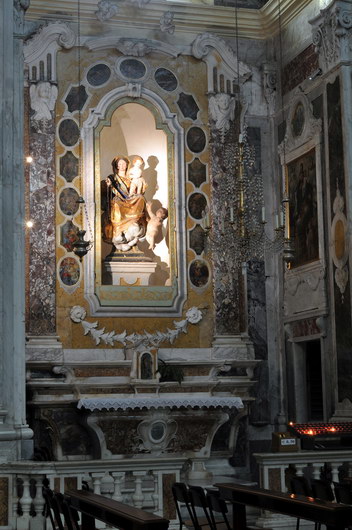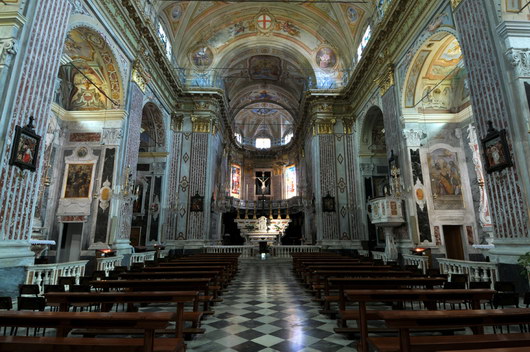 Church of Santa Croce
Church of Santa Croce | Church of Santa Croce | | Print | |
|
The Church of Santa Croce in Moneglia’s great age is all in its name: it is dedicated to the cult of the Sacred Cross, popular under Emperor Constantine (IVth century), when the Cross itself is said to have been found. The oldest document preserved to quote the Church in Moneglia itself seems to be the registry of Alessandro, book-keeper for Siro Porcello, first arch-bishop of Genova (1133-1163.) This written note certainly refers to a Parish which, by then, had already been established for a very long time.
 There are no certain traces of the first religious building erected here, while we know that the second church, consecrated by the year 1200, celebrated its holiday on the 14th of September, the Feast of the Cross. The building was enlarged in 1316 and the choir expanded, then restored, enlarged and re-done in 1390 by Giovanni Fatinanti, castellan of Moneglia, and by Bernardo from Porto Maurizio. It appears that the three-nave church enclosed most of the previous structure. In 1726, after the central nave’s dome had caved in the previous year, the church was rebuilt, this time with a single nave. The new building was 21 meters long, plus 11 meters occupied by the presbytery, and 12 meters wide, with 2.5 meters added by each of the eight side chapels. Today’s parish church, with its somber plaster façade, giving onto a risseau forecourt in white and black stones, added in 1822, has an interesting STONE RELIEF inserted in the outside right wall. The fragmentary inscription comes from Liguria, but is also reminiscent of the work of Lombard builders connected to Benedetto Antelami’s workshop. Here, two metal rings from Pisa’s port’s chain used to hang, in memory of when Genova won the symbolic chain from the Tuscan port, a few years after the Battle of Meloria, during the great naval battle of Porto Pisano. Both sides of the Ligurian region, the East and West Riviere, took part to the battle – this is symbolized by two armed horsemen, one large and one small, with short tunics, holding lances.
The theme of the Sacred Cross is echoed in two paintings, presently hanging on the counter-façade, depicting the Triumph of the Cross (an eighteenth-century work, originally set in the Church's choir, probably moved at the beginning of the twentieth century after restoration works on the presbytery), and the Cross among Our Lady of Sorrows and Saint John the Baptist, an eighteenth-century work originally part of the decoration of an unidentified, disused Church in Genova (perhaps San Domenico?), painted and purchased, respectively, in 1836, from the fabbriceria, the religious workshop dedicated to maintaining and furnishing sacred buildings. First chapel, baptistery.
 The present space, enlarged by breaking a wall and incorporating the pre-existing Oratory of Death and Prayer (1876), took the place of a chapel dedicated to Saint John the Baptist, under the jus patronatus – the authority to protect, maintain, and profit from, a church or part of a religious building – of the Multedo family. Within this chapel there are a BAPTISIMAL FOUNT, sculpted by Lorenzo De Ferrari (Torino, second half of the nineteenth century– beginning of the twentieth), a PROCESSIONAL CRUCIFIX, wooden, from the region of Liguria, originally in the close-by Oratory of the Disciplinanti, and two oval paintings, dating from the twentieth century, of the Sacred Heart of Jesus and the Sacred Heart of Mary. Second chapel, Saint John Bosco (previously of Saints Bartholomew, Lucy and Apollonia) Part of the altar table is a painting from the twentieth century, depicting Saint John Bosco, probably by Giulio CORIO (Lauriano, Torino, 1881 – Riva 1984). Third chapel, Our Lady of the Rosary.  A niche in the altar table holds the wooden sculpture, from Liguria, eighteenth-century, depicting Our Lady of the Rosary with Baby Jesus. The rest of the table is comprised by the Mysteries of the Rosary, some oval, some in different geometrical shapes, oil on copper, work on an unknown eighteenth-century artist from the region. The Annunciation, Visitation and Crowning of the Virgin are contemporary copies, replacing the originals which were lost. Fourth chapel, Triumph of the Cross. Juspatronate of the Multedo family.  A thirteenth-century wooden CROSS, painted in the Tuscan area (?) dominates the altar. The work was fully repainted and restored in 1933 by painter Giulio CORIO (Lauriano, Torino, 1881- Riva 1984.)
The MAIN ALTAR, in white inlayed marble, from an eighteenth-century ligurian workshop, was sculpted between 1749 and 1769. Behind it, the WOODEN CHOIR, made in a ligurian workshop in the seventeenth century, displays the ruined crest of arms of the Archbishop of Genova, Giovanni LERCARI (1767-1802.) Above it is the ORGAN, created by Lorenzo and Raffaello PAOLI in 1861. Fourth chapel, Mary's Visitation to Saint Elisabeth. Juspatronate of the Pagliettini family. A nineteenth-century painting depicts the Virgin’s Visitation to Saint Elisabeth. Although the style is eighteenth-century, the canvas was painted by Antonio Puppo in Genova in 1835 (signed and dated.) Third chapel, the Immaculate Conception and Saints Peter and Paul, restored by the Roverano family.

The altar's marble niche holds the precious wooden sculpture of the Immaculate Conception, of Genoese school, from the first half of the eighteenth century. The sculpture, originally placed in the chapel of the Immaculate Conception in Saint George’s church in Moneglia, was probably moved here in 1818. Second chapel, Saint Catherine from Genova. Restored by the Fidanza family in the eighteenth century.

The altar piece inserted in the front part depicts the Apparition of Christ, carrying the Cross, to Saint Catherine from Genova, in the presence of Saint Vincent Ferrer and Saint Camillo from Lellis (?)

The PULPIT is Carrara marble, inlayed with polychromatic marble, and dated 1886. The dome’s FRESCOED DECORATION, from the twentieth century, is composed by different square or rectangular areas, separated by compositions of different lines and shapes, giving the illusion of unfolding sheets of paper. Each area is frescoed with an episode from the life of Christ. On the presbytery's arch, to the left and to the right, respectively, of the City of Genova's crest of arms, are two round paintings of Mother Giovanna Maria Battista Solimani (Genova 1688-1758), founder of the Ordine delle Romite Battistine, a hermit orders of nuns dedicated to Saint John the Baptist, and of Domenico Francesco Olivieri (Genova 1691- 1766), Moneglia’s “holy” Archpriest (to the right.)  SACRISTY Among the notable furnishings preserved here, an interesting painting of the Last Supper, from the end of the sixteenth century, attributed to Luca Cambiaso's workshop (Moneglia, 1527 – El Escorial, 1585). Descriptions care of Agnese Avena
Parish of Moneglia Holy Mass timetables Da Lunedì 6 Ottobre 08 a Domenica 7 giugno 09 17,30 Santa Croce Sabato prefestivo 08,30 San Giorgio 16,30 Sant'Anna di Comeglio
|